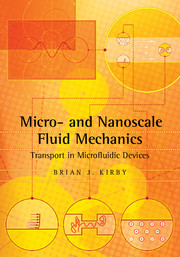Book contents
- Frontmatter
- Contents
- Preface
- Nomenclature
- Introduction
- 1 Kinematics, Conservation Equations, and Boundary Conditions for Incompressible Flow
- 2 Unidirectional Flow
- 3 Hydraulic Circuit Analysis
- 4 Passive Scalar Transport: Dispersion, Patterning, and Mixing
- 5 Electrostatics and Electrodynamics
- 6 Electroosmosis
- 7 Potential Fluid Flow
- 8 Stokes Flow
- 9 The Diffuse Structure of the Electrical Double Layer
- 10 Zeta Potential in Microchannels
- 11 Species and Charge Transport
- 12 Microchip Chemical Separations
- 13 Particle Electrophoresis
- 14 DNA Transport and Analysis
- 15 Nanofluidics: Fluid and Current Flow in Molecular-Scale and Thick-EDL Systems
- 16 AC Electrokinetics and the Dynamics of Diffuse Charge
- 17 Particle and Droplet Actuation: Dielectrophoresis, Magnetophoresis, and Digital Microfluidics
- APPENDIX A Units and Fundamental Constants
- APPENDIX B Properties of Electrolyte Solutions
- APPENDIX C Coordinate Systems and Vector Calculus
- APPENDIX D Governing Equation Reference
- APPENDIX E Nondimensionalization and Characteristic Parameters
- APPENDIX F Multipolar Solutions to the Laplace and Stokes Equations
- APPENDIX G Complex Functions
- APPENDIX H Interaction Potentials: Atomistic Modeling of Solvents and Solutes
- Bibliography
- Index
15 - Nanofluidics: Fluid and Current Flow in Molecular-Scale and Thick-EDL Systems
Published online by Cambridge University Press: 05 June 2012
- Frontmatter
- Contents
- Preface
- Nomenclature
- Introduction
- 1 Kinematics, Conservation Equations, and Boundary Conditions for Incompressible Flow
- 2 Unidirectional Flow
- 3 Hydraulic Circuit Analysis
- 4 Passive Scalar Transport: Dispersion, Patterning, and Mixing
- 5 Electrostatics and Electrodynamics
- 6 Electroosmosis
- 7 Potential Fluid Flow
- 8 Stokes Flow
- 9 The Diffuse Structure of the Electrical Double Layer
- 10 Zeta Potential in Microchannels
- 11 Species and Charge Transport
- 12 Microchip Chemical Separations
- 13 Particle Electrophoresis
- 14 DNA Transport and Analysis
- 15 Nanofluidics: Fluid and Current Flow in Molecular-Scale and Thick-EDL Systems
- 16 AC Electrokinetics and the Dynamics of Diffuse Charge
- 17 Particle and Droplet Actuation: Dielectrophoresis, Magnetophoresis, and Digital Microfluidics
- APPENDIX A Units and Fundamental Constants
- APPENDIX B Properties of Electrolyte Solutions
- APPENDIX C Coordinate Systems and Vector Calculus
- APPENDIX D Governing Equation Reference
- APPENDIX E Nondimensionalization and Characteristic Parameters
- APPENDIX F Multipolar Solutions to the Laplace and Stokes Equations
- APPENDIX G Complex Functions
- APPENDIX H Interaction Potentials: Atomistic Modeling of Solvents and Solutes
- Bibliography
- Index
Summary
To this point, we have considered flow in channels whose dimension was large relative to the Debye length or the size of any molecules or particles suspended in the flow. When we use channels with shallow (e.g., nanoscale) depths d, we cannot separate the EDL from the bulk fluid by using boundary-layer theory; instead, we must account for the presence of net charge density in the bulk flow field. Even if the double layers remain thin, the perturbative effects of double layers (for example, surface conductance) are more significant as the channel becomes small. Because these phenomena typically coincide with transport through nanoscale channels, the term nanofluidics is often used to refer to flows with small d * or flows with molecules or particles comparable to the size of the channel, though the scale need not be nanoscopic for these phenomena to be important, and these phenomena are unimportant in some nanoscale flows. Despite this, some authors use the term nanofluidics to refer specifically to flows in nanoscale channels with no reference to molecular size or λD. Because our interest is the interplay of electrokinetic effects with channels and molecular-scale confinement, our focus is on channels with molecular scale or of a size comparable to λD, and we pay only cursory attention to the absolute dimension of the channel.
For unidirectional flow in infinitely long, uniform-cross-section channels, thick-EDL effects are observed primarily through changes in the elements of the electrokinetic coupling matrix.
- Type
- Chapter
- Information
- Micro- and Nanoscale Fluid MechanicsTransport in Microfluidic Devices, pp. 336 - 354Publisher: Cambridge University PressPrint publication year: 2010



